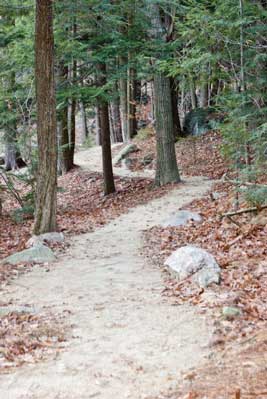Surfaces of Trails
Trail surfaces must be firm and stable. The first general exception allows achieving firmness and stability to the extent practicable if a condition for an exception prohibits full compliance with surface requirements.
Paving with concrete or asphalt is appropriate for highly developed areas. For less developed settings, crushed gravel, fine crusher rejects, packed soil, and other natural materials may provide a firm and stable surface (figure 128). Natural materials also can be combined with synthetic bonding materials that provide stability and firmness. These materials may not be suitable for every trail, which is why the deviation due to the presence of a condition for an exception is permitted.

Figure 128—Natural materials were used to build a firm and stable surface for the Crotched Mountain Trail in New Hampshire.
Slip resistance is not required for trails. Tree and shrub leaves and needles, dirt, ice, snow, other surface debris, and weather conditions are part of the natural environment and would be difficult, if not impossible, to avoid.
FSTAG defines a firm surface as one that resists deformations by indentations. (See DESIGN TIP—Use a rule of thumb to estimate firmness and stability., page 37.) Natural soils should be evaluated for their ability to be compacted into a firm and stable surface under normally occurring weather conditions during the primary season of use. When evaluating surface material suitability, keep in mind that FSTAG defines a stable surface as a trail surface that is not permanently affected by normal weather conditions and that is able to sustain wear and tear produced by normal use between planned maintenance cycles. Local trail managers are a good source of information because they know the local surfaces and how they wear throughout the primary seasons for which the trail is managed.

User Comments/Questions
Add Comment/Question